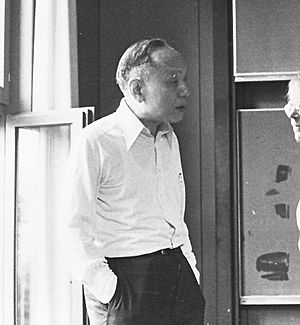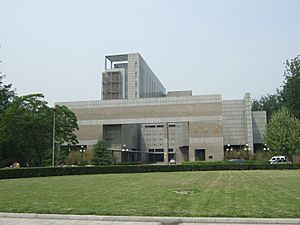Shiing-Shen Chern facts for kids
Quick facts for kids
Shiing-Shen Chern
陳省身 |
|||||||||||||
|---|---|---|---|---|---|---|---|---|---|---|---|---|---|

Shiing-Shen Chern in 1976
|
|||||||||||||
| Born | October 28, 1911 |
||||||||||||
| Died | December 3, 2004 (aged 93) Tianjin, China
|
||||||||||||
| Nationality | Chinese and American | ||||||||||||
| Citizenship | China and United States | ||||||||||||
| Alma mater | Nankai University University of Hamburg |
||||||||||||
| Known for | Chern class Chern–Gauss–Bonnet theorem Chern–Simons theory Chern–Simons form Chern–Weil theory Chern–Weil homomorphism Chern's conjecture Chern's conjecture (differential geometry) Chern–Bott formula Chern–Lashof theory |
||||||||||||
| Children | 2 | ||||||||||||
| Awards |
|
||||||||||||
| Scientific career | |||||||||||||
| Fields | Mathematics | ||||||||||||
| Institutions | Tsinghua University Institute for Advanced Study University of Chicago University of California, Berkeley Mathematical Sciences Research Institute Nankai University |
||||||||||||
| Thesis | Eine Invariantentheorie der Dreigewebe aus r-dimensionalen Mannigfaltigkeiten im  |
||||||||||||
| Doctoral advisor | Wilhelm Blaschke | ||||||||||||
| Doctoral students | Louis Auslander Thomas Banchoff Manfredo do Carmo Robert B. Gardner Howard Garland Harold Levine Katsumi Nomizu William F. Pohl Alexandre Augusto Martins Rodrigues Bernard Shiffman Liao Shantao Sidney M. Webster Alan Weinstein Joseph Wolf Shing-Tung Yau Shiu-Yuen Cheng Peter Wai-Kwong Li |
||||||||||||
| Other notable students | James Simons Chen Ning Yang |
||||||||||||
| Influences | Elie Cartan Rao Yutai |
||||||||||||
| Influenced | Phillip Griffiths Gang Tian |
||||||||||||
| Chinese name | |||||||||||||
| Traditional Chinese | 陳省身 | ||||||||||||
| Simplified Chinese | 陈省身 | ||||||||||||
|
|||||||||||||
Shiing-Shen Chern (pronounced "Churn") was a famous Chinese-American mathematician and poet. He was born on October 28, 1911, and passed away on December 3, 2004. He made huge contributions to a field of math called differential geometry and topology. Many people call him the "father of modern differential geometry." He is seen as one of the greatest mathematicians of the 1900s.
Chern won many awards, including the Wolf Prize and the first-ever Shaw Prize. To honor his memory, the International Mathematical Union created the Chern Medal in 2010. This medal recognizes mathematicians who have achieved outstanding things.
Chern worked at important places like the Institute for Advanced Study and the University of Chicago. He also moved to the University of California, Berkeley. There, he helped start the Mathematical Sciences Research Institute (MSRI) in 1982 and was its first director. His work, especially the Chern-Gauss-Bonnet Theorem, Chern–Simons theory, and Chern classes, is still very important today. It influences research in math, like geometry and knot theory, and in physics, such as string theory and quantum field theory.
Contents
About Shiing-Shen Chern
His Early Life and Education
Shiing-Shen Chern was born in Jiaxing, China, in 1911. He moved to Tianjin in 1922 with his father. At age 15, he started studying at Nankai University in Tianjin. He was interested in physics but preferred math because he didn't enjoy lab work. He earned his Bachelor of Science degree in 1930.
After Nankai, Chern became a teaching assistant at Tsinghua University in Beijing. He also studied there as a graduate student. In 1934, he earned his master's degree. This was the first master's degree in mathematics ever given in China.
Studying in Europe
In 1934, Chern received a scholarship to study abroad. He chose to go to Germany to study geometry, which was a leading field in Europe at the time. He studied at the University of Hamburg with a famous mathematician named Wilhelm Blaschke.
Chern finished his degree very quickly, in just two years. He earned his PhD in February 1936. His thesis was written in German. After that, he spent a year studying in Paris, France, where he met another very important mathematician, Élie Cartan. Chern said that Cartan would often send him letters with more thoughts and questions after their meetings.
Returning to China During Wartime
In 1937, Chern returned to China and became a professor at Tsinghua University. However, World War 2 soon began. This forced his university and others to move away from Beijing. They formed a temporary university called the National Southwestern Associated University in Kunming.
In 1939, Chern married Shih-Ning Cheng. They had two children, Paul and May. The war made it hard for Chern to connect with other mathematicians. But he kept working hard on his research. In 1943, his work became known internationally. He was invited to the Institute for Advanced Study (IAS) in the United States.
Important Work in the United States
From 1943 to 1945, Chern worked at the Institute for Advanced Study in Princeton, New Jersey. Here, he worked with André Weil on important math ideas. This period was a turning point in his career.
His most famous work during this time was a generalization of the Gauss–Bonnet theorem. This new version is now called the Chern–Gauss–Bonnet theorem. It is considered his greatest achievement. This work greatly changed the fields of differential geometry and algebraic geometry.
Back to China and Then Chicago
After the war, Chern returned to Shanghai in 1945. He helped create the Institute of Mathematics of the Academia Sinica. In 1948, he became one of the youngest members elected to the Academia Sinica.
Later in 1948, he went back to the United States. In 1949, he became a math professor at the University of Chicago. He was the head of the geometry department there.
Berkeley and MSRI
In 1960, Chern moved to the University of California, Berkeley. He worked there until he retired in 1979. In 1961, he became a citizen of the United States. He also became a member of the United States National Academy of Sciences.
In 1981, Chern helped found the Mathematical Sciences Research Institute (MSRI) at Berkeley. He was its director until 1984. MSRI is now one of the biggest and most important math institutes in the world. One of his PhD students during this time was Shing-Tung Yau, who later won the Fields Medal in 1982.
Chern played a big role in making the U.S. a leader in geometry research. He was always modest about his achievements.
Building Bridges Between East and West
In 1972, the United States and China began to have better relations. This allowed American citizens to visit China. Chern visited China many times, helping to connect mathematicians from both countries.
He was highly respected by Chinese leaders. Because of his support, math research in China grew again. He helped a new generation of important Chinese mathematicians. Chern founded the Nankai Institute for Mathematics (NKIM) at his old university, Nankai. This institute was later renamed the Chern Institute of Mathematics in his honor. He was seen as a hero in China.
His Final Years
In 1999, Chern moved back to Tianjin, China, permanently. He lived there until he passed away in 2004. In 2002, he helped convince the Chinese government to host the International Congress of Mathematicians in Beijing. This was a very important event for math in China.
Shiing-Shen Chern died of heart failure in 2004 at the age of 93. His former home, Ningyuan, at Nankai University, is now open to visitors every year on December 3rd to remember him.
His Amazing Math Discoveries
Physics Nobel Prize winner C. N. Yang, who was also Chern's student, said that Chern was as important as famous mathematicians like Euclid and Gauss. Two of Chern's most important contributions that changed geometry and topology are:
- Chern-Gauss-Bonnet Theorem: This is a more advanced version of the famous Gauss–Bonnet theorem. Chern proved it by creating his own geometric theory. He considered this his greatest work.
- Chern classes: These are math tools that have been used in many areas of modern physics, like string theory. Chern's main idea was to study geometry and topology using complex numbers.
Phillip Griffiths, a student of Chern, said that Chern "defined the subject of global differential geometry." He helped shape large areas of modern mathematics for almost 70 years.
Using Differential Forms
Chern, along with Élie Cartan, helped make differential forms popular in math and physics. Differential forms are a special way to study shapes and spaces. They are useful because they can be used for both local (small area) and global (large area) properties of shapes. Chern once said that "vector fields are like a man, and differential forms are like a woman. Society must have two sexes."
In his later years, he also promoted the study of Finsler geometry. This is another area of geometry that his students continue to research.
Awards and Recognition
Chern received many awards and honors throughout his life. Some of the most important include:
- 1970: Chauvenet Prize
- 1975: National Medal of Science
- 1983: Wolf Prize in Mathematics
- 2002: Lobachevsky Medal
- 2004: Shaw Prize in mathematical sciences
He was also a member of many important scientific groups around the world, like the United States National Academy of Sciences and the Royal Society of London.
Things Named After Him
Several things are named in honor of Shiing-Shen Chern:
- The asteroid 29552 Chern
- The Chern Medal, a top award in mathematics
- The Shiing-Shen Chern Prize, given by the Association of Chinese Mathematicians
- The Chern Institute of Mathematics at Nankai University
- The Chern Lectures and the Shiing-Shen Chern Chair in Mathematics at UC Berkeley
Chern enjoyed playing contract bridge and Go (game). He also liked reading Chinese adventure stories (Wuxia) and was interested in Chinese history and philosophy. He could speak German, French, English, and Chinese. People said he had a strong presence and that others listened to him.
His Students
Chern had 43 students, and over 1000 "math descendants" (students of his students, and so on). Some of his most famous students include:
- Shing-Tung Yau, who won the Fields Medal.
- Chen-Ning Yang, who won the Nobel Prize in Physics.
- James Harris Simons, who later became a very successful hedge fund manager. Simons often talks about Chern in his speeches.
Chern loved working with and guiding young mathematicians. Many of his students went on to become very successful themselves.
His Family Life
Chern's wife was Shih-ning Cheng. They married in 1939, and she passed away in 2000. They had two children, a daughter named May Chu and a son named Paul. Chern wrote that his wife played a huge role in his life and work. He said that any credit for his math work belonged to her as well as him. His children described him as an easygoing parent who often knew what was best for them before they did.
How to Say His Name
Chern's last name is a common Chinese name, usually spelled "Chen" today. The spelling "Chern" comes from an older way of writing Chinese sounds called Gwoyeu Romatzyh. This spelling helped show the different tones in Mandarin Chinese.
In English, Chern himself pronounced his name "Churn." This pronunciation is now used by most English-speaking mathematicians and physicists.
 In Spanish: Shiing-Shen Chern para niños
In Spanish: Shiing-Shen Chern para niños


